Media's Impact on Indigenous Mental Health: An Australian Perspective
VerifiedAdded on 2022/10/19
|10
|2435
|14
Essay
AI Summary
This essay delves into the critical issue of mental health disparities within Australia's Indigenous populations, analyzing the influence of media in shaping perceptions and awareness. It examines various media items, evaluating their role in investigating and addressing mental disorders prevalent among Indigenous communities. The essay assesses multiple articles, focusing on governmental health promotion initiatives, culturally adapted interventions, and global health disparities. It highlights the impact of factors such as socioeconomic conditions, access to health services, and the prevalence of suicide rates linked to mental disorders. The analysis considers the positive, negative, and neutral portrayals in the media, emphasizing the need for improved healthcare practices and interventions to promote the mental wellbeing of Indigenous Australians. References include various research papers and government publications to support the analysis and conclusions.
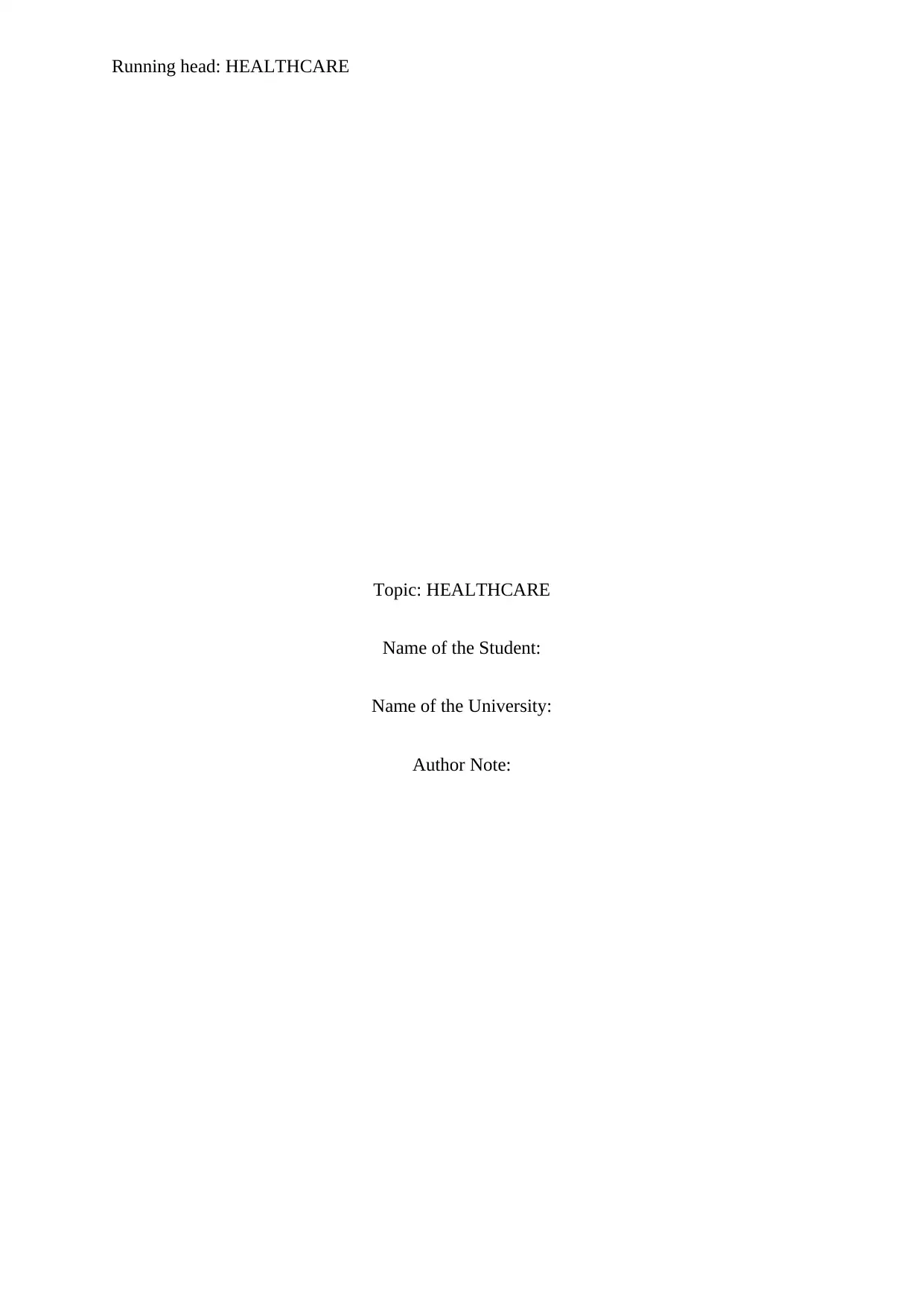
Running head: HEALTHCARE
Topic: HEALTHCARE
Name of the Student:
Name of the University:
Author Note:
Topic: HEALTHCARE
Name of the Student:
Name of the University:
Author Note:
Paraphrase This Document
Need a fresh take? Get an instant paraphrase of this document with our AI Paraphraser
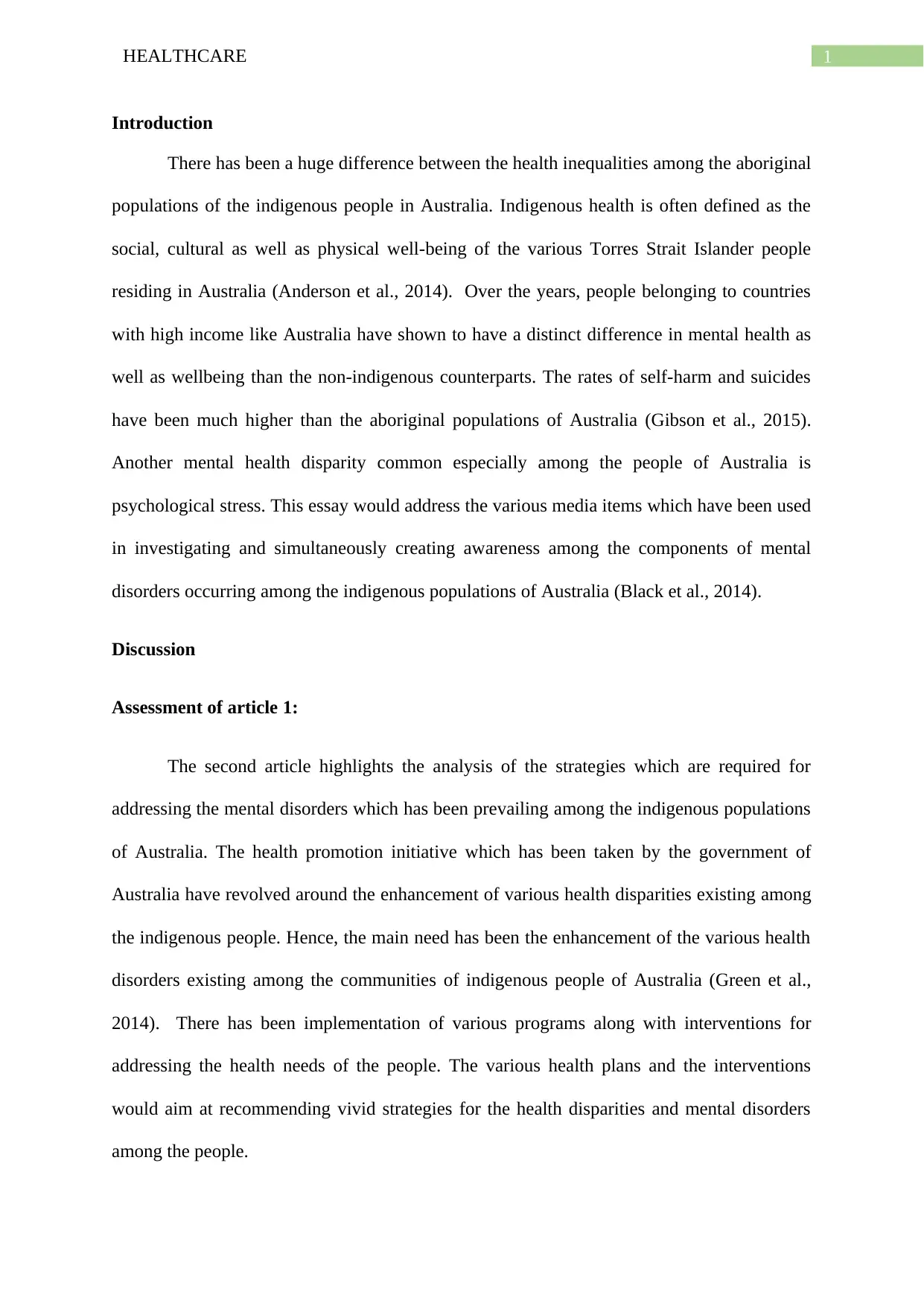
1HEALTHCARE
Introduction
There has been a huge difference between the health inequalities among the aboriginal
populations of the indigenous people in Australia. Indigenous health is often defined as the
social, cultural as well as physical well-being of the various Torres Strait Islander people
residing in Australia (Anderson et al., 2014). Over the years, people belonging to countries
with high income like Australia have shown to have a distinct difference in mental health as
well as wellbeing than the non-indigenous counterparts. The rates of self-harm and suicides
have been much higher than the aboriginal populations of Australia (Gibson et al., 2015).
Another mental health disparity common especially among the people of Australia is
psychological stress. This essay would address the various media items which have been used
in investigating and simultaneously creating awareness among the components of mental
disorders occurring among the indigenous populations of Australia (Black et al., 2014).
Discussion
Assessment of article 1:
The second article highlights the analysis of the strategies which are required for
addressing the mental disorders which has been prevailing among the indigenous populations
of Australia. The health promotion initiative which has been taken by the government of
Australia have revolved around the enhancement of various health disparities existing among
the indigenous people. Hence, the main need has been the enhancement of the various health
disorders existing among the communities of indigenous people of Australia (Green et al.,
2014). There has been implementation of various programs along with interventions for
addressing the health needs of the people. The various health plans and the interventions
would aim at recommending vivid strategies for the health disparities and mental disorders
among the people.
Introduction
There has been a huge difference between the health inequalities among the aboriginal
populations of the indigenous people in Australia. Indigenous health is often defined as the
social, cultural as well as physical well-being of the various Torres Strait Islander people
residing in Australia (Anderson et al., 2014). Over the years, people belonging to countries
with high income like Australia have shown to have a distinct difference in mental health as
well as wellbeing than the non-indigenous counterparts. The rates of self-harm and suicides
have been much higher than the aboriginal populations of Australia (Gibson et al., 2015).
Another mental health disparity common especially among the people of Australia is
psychological stress. This essay would address the various media items which have been used
in investigating and simultaneously creating awareness among the components of mental
disorders occurring among the indigenous populations of Australia (Black et al., 2014).
Discussion
Assessment of article 1:
The second article highlights the analysis of the strategies which are required for
addressing the mental disorders which has been prevailing among the indigenous populations
of Australia. The health promotion initiative which has been taken by the government of
Australia have revolved around the enhancement of various health disparities existing among
the indigenous people. Hence, the main need has been the enhancement of the various health
disorders existing among the communities of indigenous people of Australia (Green et al.,
2014). There has been implementation of various programs along with interventions for
addressing the health needs of the people. The various health plans and the interventions
would aim at recommending vivid strategies for the health disparities and mental disorders
among the people.
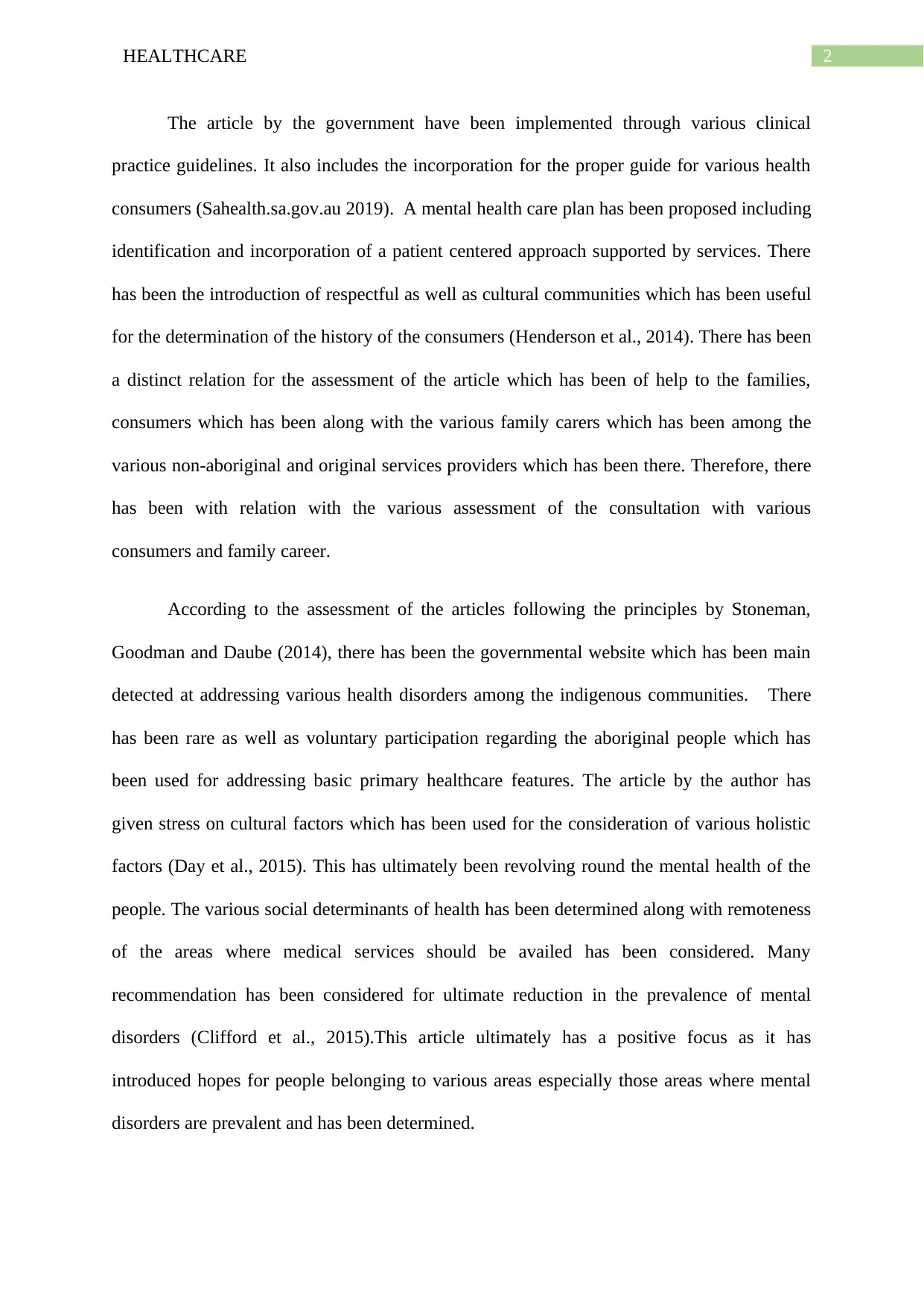
2HEALTHCARE
The article by the government have been implemented through various clinical
practice guidelines. It also includes the incorporation for the proper guide for various health
consumers (Sahealth.sa.gov.au 2019). A mental health care plan has been proposed including
identification and incorporation of a patient centered approach supported by services. There
has been the introduction of respectful as well as cultural communities which has been useful
for the determination of the history of the consumers (Henderson et al., 2014). There has been
a distinct relation for the assessment of the article which has been of help to the families,
consumers which has been along with the various family carers which has been among the
various non-aboriginal and original services providers which has been there. Therefore, there
has been with relation with the various assessment of the consultation with various
consumers and family career.
According to the assessment of the articles following the principles by Stoneman,
Goodman and Daube (2014), there has been the governmental website which has been main
detected at addressing various health disorders among the indigenous communities. There
has been rare as well as voluntary participation regarding the aboriginal people which has
been used for addressing basic primary healthcare features. The article by the author has
given stress on cultural factors which has been used for the consideration of various holistic
factors (Day et al., 2015). This has ultimately been revolving round the mental health of the
people. The various social determinants of health has been determined along with remoteness
of the areas where medical services should be availed has been considered. Many
recommendation has been considered for ultimate reduction in the prevalence of mental
disorders (Clifford et al., 2015).This article ultimately has a positive focus as it has
introduced hopes for people belonging to various areas especially those areas where mental
disorders are prevalent and has been determined.
The article by the government have been implemented through various clinical
practice guidelines. It also includes the incorporation for the proper guide for various health
consumers (Sahealth.sa.gov.au 2019). A mental health care plan has been proposed including
identification and incorporation of a patient centered approach supported by services. There
has been the introduction of respectful as well as cultural communities which has been useful
for the determination of the history of the consumers (Henderson et al., 2014). There has been
a distinct relation for the assessment of the article which has been of help to the families,
consumers which has been along with the various family carers which has been among the
various non-aboriginal and original services providers which has been there. Therefore, there
has been with relation with the various assessment of the consultation with various
consumers and family career.
According to the assessment of the articles following the principles by Stoneman,
Goodman and Daube (2014), there has been the governmental website which has been main
detected at addressing various health disorders among the indigenous communities. There
has been rare as well as voluntary participation regarding the aboriginal people which has
been used for addressing basic primary healthcare features. The article by the author has
given stress on cultural factors which has been used for the consideration of various holistic
factors (Day et al., 2015). This has ultimately been revolving round the mental health of the
people. The various social determinants of health has been determined along with remoteness
of the areas where medical services should be availed has been considered. Many
recommendation has been considered for ultimate reduction in the prevalence of mental
disorders (Clifford et al., 2015).This article ultimately has a positive focus as it has
introduced hopes for people belonging to various areas especially those areas where mental
disorders are prevalent and has been determined.
⊘ This is a preview!⊘
Do you want full access?
Subscribe today to unlock all pages.

Trusted by 1+ million students worldwide
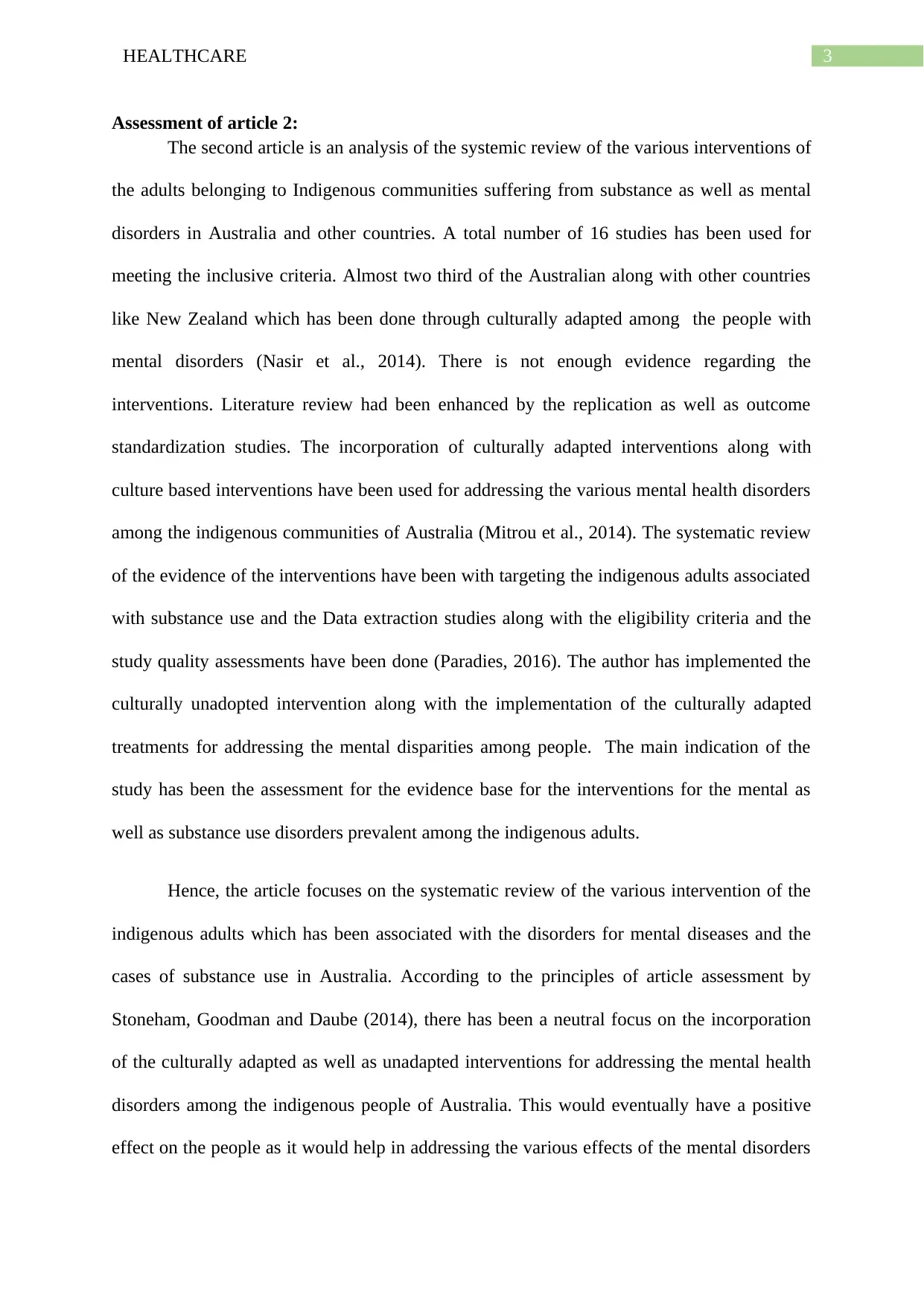
3HEALTHCARE
Assessment of article 2:
The second article is an analysis of the systemic review of the various interventions of
the adults belonging to Indigenous communities suffering from substance as well as mental
disorders in Australia and other countries. A total number of 16 studies has been used for
meeting the inclusive criteria. Almost two third of the Australian along with other countries
like New Zealand which has been done through culturally adapted among the people with
mental disorders (Nasir et al., 2014). There is not enough evidence regarding the
interventions. Literature review had been enhanced by the replication as well as outcome
standardization studies. The incorporation of culturally adapted interventions along with
culture based interventions have been used for addressing the various mental health disorders
among the indigenous communities of Australia (Mitrou et al., 2014). The systematic review
of the evidence of the interventions have been with targeting the indigenous adults associated
with substance use and the Data extraction studies along with the eligibility criteria and the
study quality assessments have been done (Paradies, 2016). The author has implemented the
culturally unadopted intervention along with the implementation of the culturally adapted
treatments for addressing the mental disparities among people. The main indication of the
study has been the assessment for the evidence base for the interventions for the mental as
well as substance use disorders prevalent among the indigenous adults.
Hence, the article focuses on the systematic review of the various intervention of the
indigenous adults which has been associated with the disorders for mental diseases and the
cases of substance use in Australia. According to the principles of article assessment by
Stoneham, Goodman and Daube (2014), there has been a neutral focus on the incorporation
of the culturally adapted as well as unadapted interventions for addressing the mental health
disorders among the indigenous people of Australia. This would eventually have a positive
effect on the people as it would help in addressing the various effects of the mental disorders
Assessment of article 2:
The second article is an analysis of the systemic review of the various interventions of
the adults belonging to Indigenous communities suffering from substance as well as mental
disorders in Australia and other countries. A total number of 16 studies has been used for
meeting the inclusive criteria. Almost two third of the Australian along with other countries
like New Zealand which has been done through culturally adapted among the people with
mental disorders (Nasir et al., 2014). There is not enough evidence regarding the
interventions. Literature review had been enhanced by the replication as well as outcome
standardization studies. The incorporation of culturally adapted interventions along with
culture based interventions have been used for addressing the various mental health disorders
among the indigenous communities of Australia (Mitrou et al., 2014). The systematic review
of the evidence of the interventions have been with targeting the indigenous adults associated
with substance use and the Data extraction studies along with the eligibility criteria and the
study quality assessments have been done (Paradies, 2016). The author has implemented the
culturally unadopted intervention along with the implementation of the culturally adapted
treatments for addressing the mental disparities among people. The main indication of the
study has been the assessment for the evidence base for the interventions for the mental as
well as substance use disorders prevalent among the indigenous adults.
Hence, the article focuses on the systematic review of the various intervention of the
indigenous adults which has been associated with the disorders for mental diseases and the
cases of substance use in Australia. According to the principles of article assessment by
Stoneham, Goodman and Daube (2014), there has been a neutral focus on the incorporation
of the culturally adapted as well as unadapted interventions for addressing the mental health
disorders among the indigenous people of Australia. This would eventually have a positive
effect on the people as it would help in addressing the various effects of the mental disorders
Paraphrase This Document
Need a fresh take? Get an instant paraphrase of this document with our AI Paraphraser
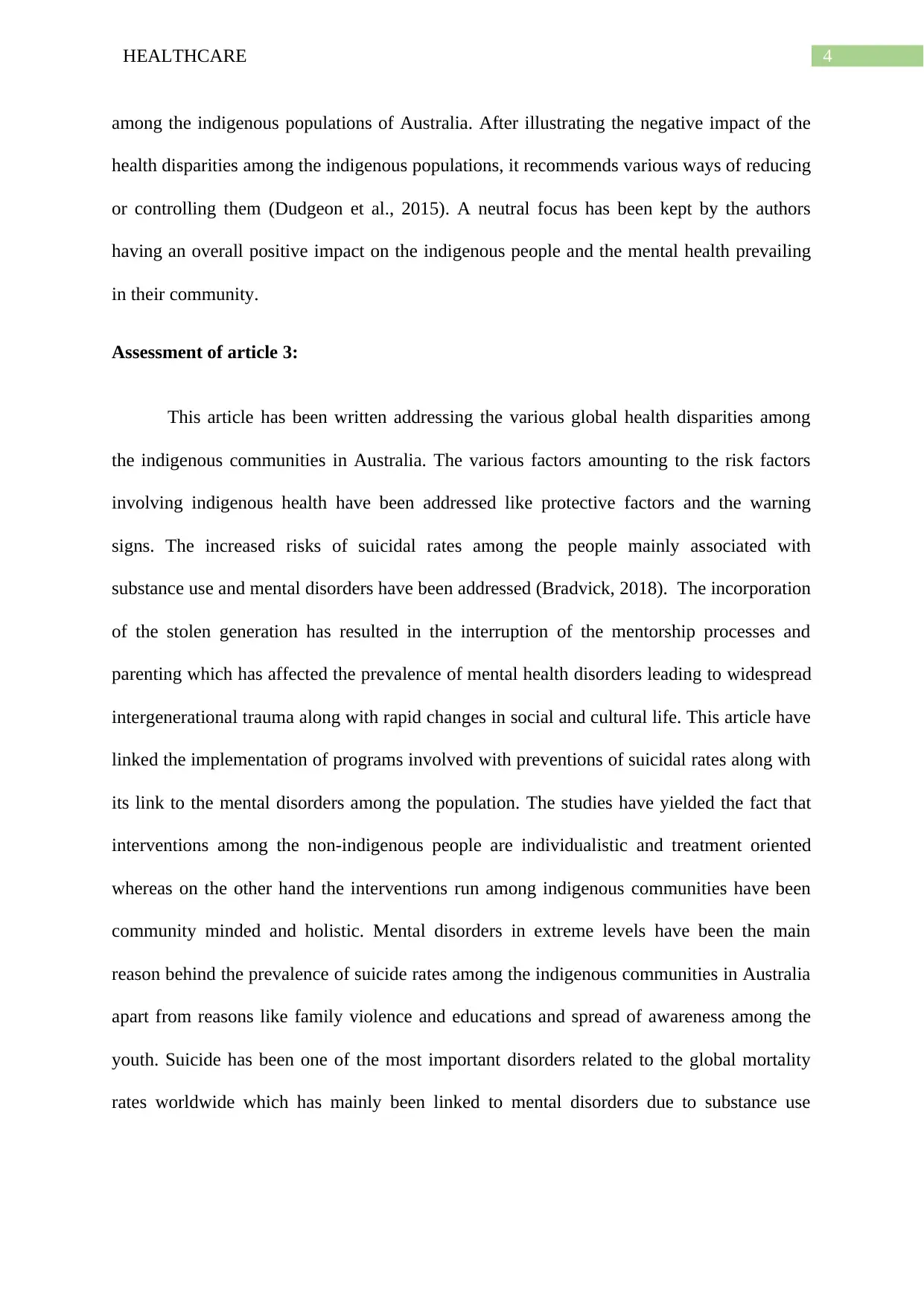
4HEALTHCARE
among the indigenous populations of Australia. After illustrating the negative impact of the
health disparities among the indigenous populations, it recommends various ways of reducing
or controlling them (Dudgeon et al., 2015). A neutral focus has been kept by the authors
having an overall positive impact on the indigenous people and the mental health prevailing
in their community.
Assessment of article 3:
This article has been written addressing the various global health disparities among
the indigenous communities in Australia. The various factors amounting to the risk factors
involving indigenous health have been addressed like protective factors and the warning
signs. The increased risks of suicidal rates among the people mainly associated with
substance use and mental disorders have been addressed (Bradvick, 2018). The incorporation
of the stolen generation has resulted in the interruption of the mentorship processes and
parenting which has affected the prevalence of mental health disorders leading to widespread
intergenerational trauma along with rapid changes in social and cultural life. This article have
linked the implementation of programs involved with preventions of suicidal rates along with
its link to the mental disorders among the population. The studies have yielded the fact that
interventions among the non-indigenous people are individualistic and treatment oriented
whereas on the other hand the interventions run among indigenous communities have been
community minded and holistic. Mental disorders in extreme levels have been the main
reason behind the prevalence of suicide rates among the indigenous communities in Australia
apart from reasons like family violence and educations and spread of awareness among the
youth. Suicide has been one of the most important disorders related to the global mortality
rates worldwide which has mainly been linked to mental disorders due to substance use
among the indigenous populations of Australia. After illustrating the negative impact of the
health disparities among the indigenous populations, it recommends various ways of reducing
or controlling them (Dudgeon et al., 2015). A neutral focus has been kept by the authors
having an overall positive impact on the indigenous people and the mental health prevailing
in their community.
Assessment of article 3:
This article has been written addressing the various global health disparities among
the indigenous communities in Australia. The various factors amounting to the risk factors
involving indigenous health have been addressed like protective factors and the warning
signs. The increased risks of suicidal rates among the people mainly associated with
substance use and mental disorders have been addressed (Bradvick, 2018). The incorporation
of the stolen generation has resulted in the interruption of the mentorship processes and
parenting which has affected the prevalence of mental health disorders leading to widespread
intergenerational trauma along with rapid changes in social and cultural life. This article have
linked the implementation of programs involved with preventions of suicidal rates along with
its link to the mental disorders among the population. The studies have yielded the fact that
interventions among the non-indigenous people are individualistic and treatment oriented
whereas on the other hand the interventions run among indigenous communities have been
community minded and holistic. Mental disorders in extreme levels have been the main
reason behind the prevalence of suicide rates among the indigenous communities in Australia
apart from reasons like family violence and educations and spread of awareness among the
youth. Suicide has been one of the most important disorders related to the global mortality
rates worldwide which has mainly been linked to mental disorders due to substance use
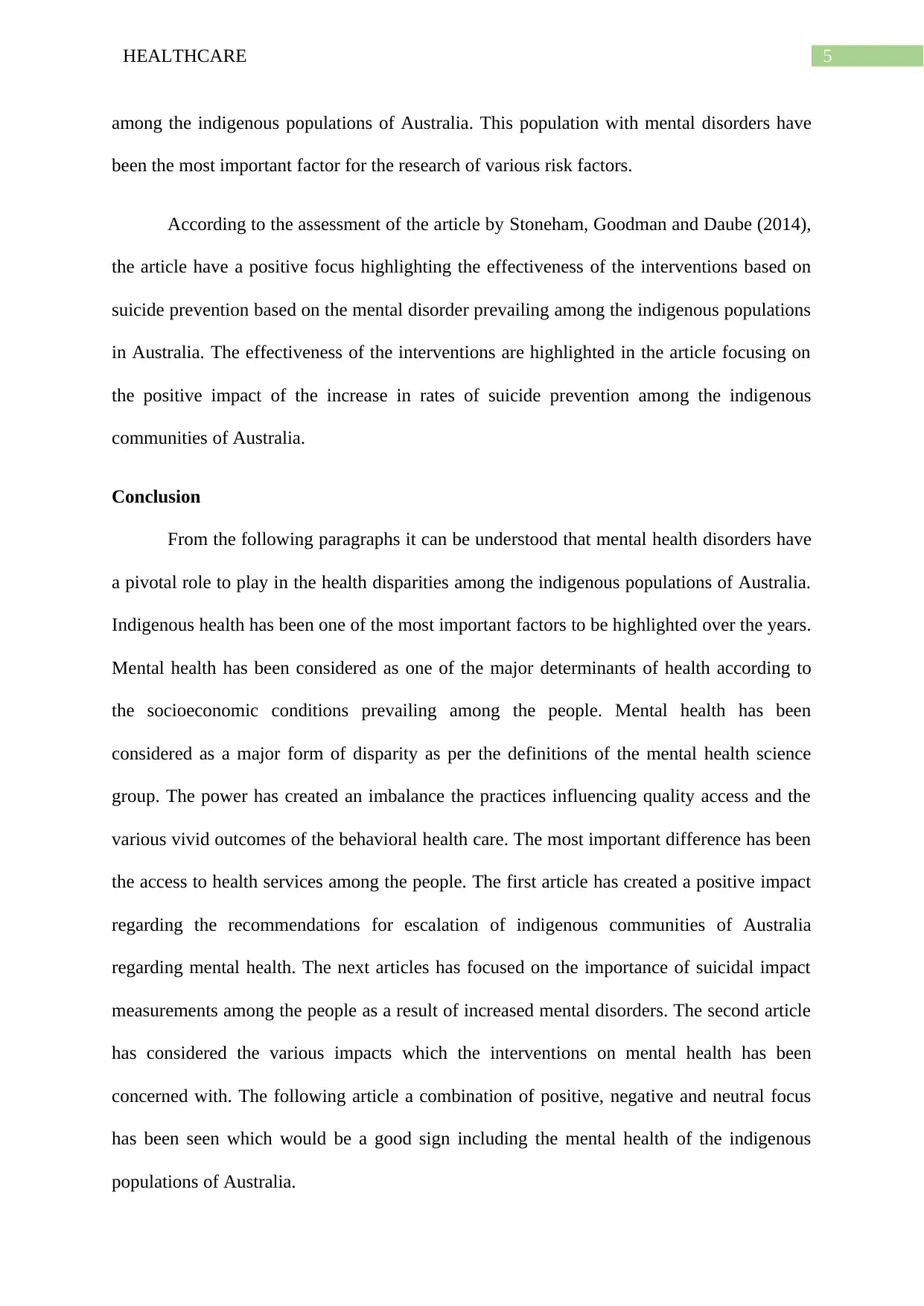
5HEALTHCARE
among the indigenous populations of Australia. This population with mental disorders have
been the most important factor for the research of various risk factors.
According to the assessment of the article by Stoneham, Goodman and Daube (2014),
the article have a positive focus highlighting the effectiveness of the interventions based on
suicide prevention based on the mental disorder prevailing among the indigenous populations
in Australia. The effectiveness of the interventions are highlighted in the article focusing on
the positive impact of the increase in rates of suicide prevention among the indigenous
communities of Australia.
Conclusion
From the following paragraphs it can be understood that mental health disorders have
a pivotal role to play in the health disparities among the indigenous populations of Australia.
Indigenous health has been one of the most important factors to be highlighted over the years.
Mental health has been considered as one of the major determinants of health according to
the socioeconomic conditions prevailing among the people. Mental health has been
considered as a major form of disparity as per the definitions of the mental health science
group. The power has created an imbalance the practices influencing quality access and the
various vivid outcomes of the behavioral health care. The most important difference has been
the access to health services among the people. The first article has created a positive impact
regarding the recommendations for escalation of indigenous communities of Australia
regarding mental health. The next articles has focused on the importance of suicidal impact
measurements among the people as a result of increased mental disorders. The second article
has considered the various impacts which the interventions on mental health has been
concerned with. The following article a combination of positive, negative and neutral focus
has been seen which would be a good sign including the mental health of the indigenous
populations of Australia.
among the indigenous populations of Australia. This population with mental disorders have
been the most important factor for the research of various risk factors.
According to the assessment of the article by Stoneham, Goodman and Daube (2014),
the article have a positive focus highlighting the effectiveness of the interventions based on
suicide prevention based on the mental disorder prevailing among the indigenous populations
in Australia. The effectiveness of the interventions are highlighted in the article focusing on
the positive impact of the increase in rates of suicide prevention among the indigenous
communities of Australia.
Conclusion
From the following paragraphs it can be understood that mental health disorders have
a pivotal role to play in the health disparities among the indigenous populations of Australia.
Indigenous health has been one of the most important factors to be highlighted over the years.
Mental health has been considered as one of the major determinants of health according to
the socioeconomic conditions prevailing among the people. Mental health has been
considered as a major form of disparity as per the definitions of the mental health science
group. The power has created an imbalance the practices influencing quality access and the
various vivid outcomes of the behavioral health care. The most important difference has been
the access to health services among the people. The first article has created a positive impact
regarding the recommendations for escalation of indigenous communities of Australia
regarding mental health. The next articles has focused on the importance of suicidal impact
measurements among the people as a result of increased mental disorders. The second article
has considered the various impacts which the interventions on mental health has been
concerned with. The following article a combination of positive, negative and neutral focus
has been seen which would be a good sign including the mental health of the indigenous
populations of Australia.
⊘ This is a preview!⊘
Do you want full access?
Subscribe today to unlock all pages.

Trusted by 1+ million students worldwide
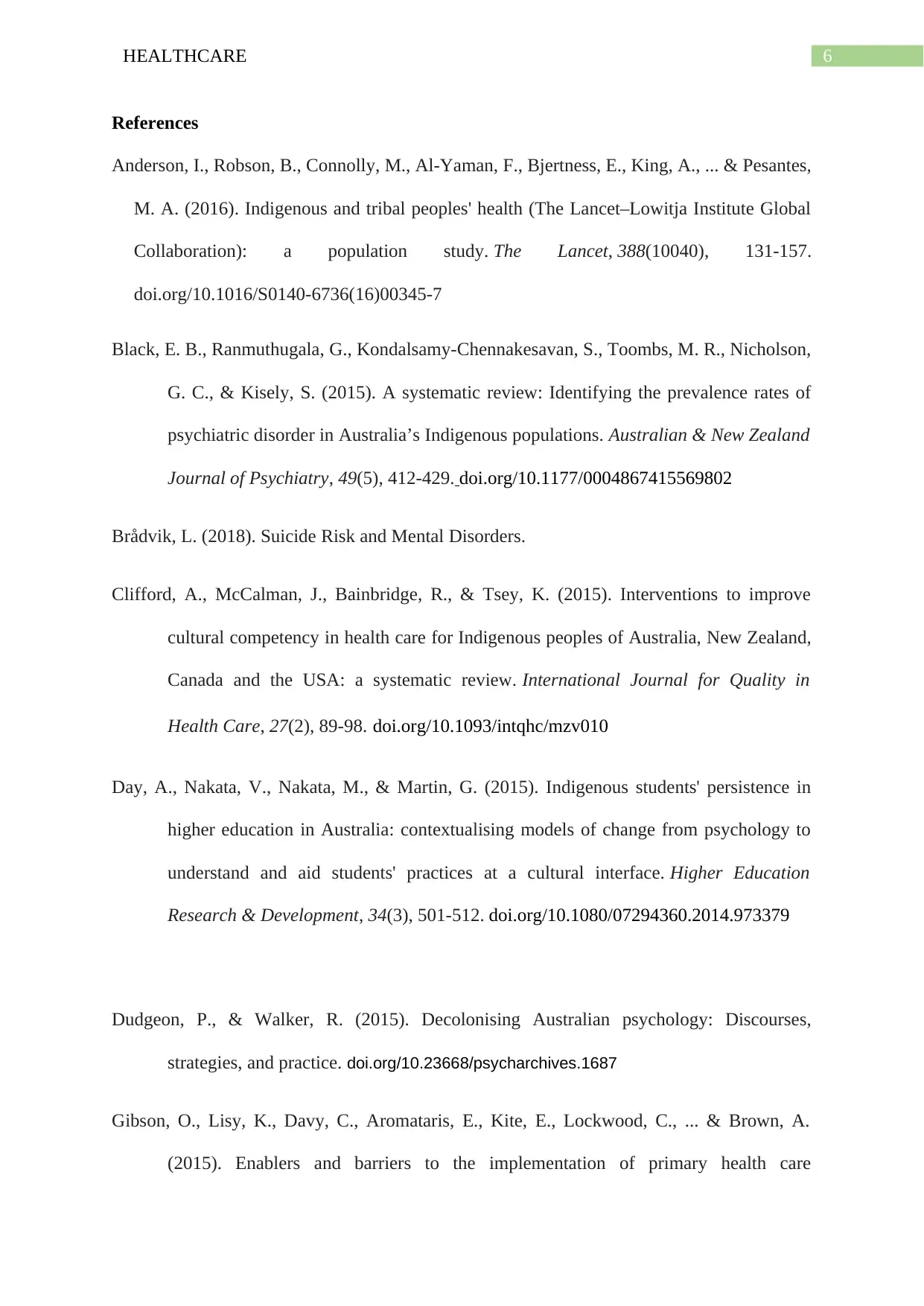
6HEALTHCARE
References
Anderson, I., Robson, B., Connolly, M., Al-Yaman, F., Bjertness, E., King, A., ... & Pesantes,
M. A. (2016). Indigenous and tribal peoples' health (The Lancet–Lowitja Institute Global
Collaboration): a population study. The Lancet, 388(10040), 131-157.
doi.org/10.1016/S0140-6736(16)00345-7
Black, E. B., Ranmuthugala, G., Kondalsamy-Chennakesavan, S., Toombs, M. R., Nicholson,
G. C., & Kisely, S. (2015). A systematic review: Identifying the prevalence rates of
psychiatric disorder in Australia’s Indigenous populations. Australian & New Zealand
Journal of Psychiatry, 49(5), 412-429. doi.org/10.1177/0004867415569802
Brådvik, L. (2018). Suicide Risk and Mental Disorders.
Clifford, A., McCalman, J., Bainbridge, R., & Tsey, K. (2015). Interventions to improve
cultural competency in health care for Indigenous peoples of Australia, New Zealand,
Canada and the USA: a systematic review. International Journal for Quality in
Health Care, 27(2), 89-98. doi.org/10.1093/intqhc/mzv010
Day, A., Nakata, V., Nakata, M., & Martin, G. (2015). Indigenous students' persistence in
higher education in Australia: contextualising models of change from psychology to
understand and aid students' practices at a cultural interface. Higher Education
Research & Development, 34(3), 501-512. doi.org/10.1080/07294360.2014.973379
Dudgeon, P., & Walker, R. (2015). Decolonising Australian psychology: Discourses,
strategies, and practice. doi.org/10.23668/psycharchives.1687
Gibson, O., Lisy, K., Davy, C., Aromataris, E., Kite, E., Lockwood, C., ... & Brown, A.
(2015). Enablers and barriers to the implementation of primary health care
References
Anderson, I., Robson, B., Connolly, M., Al-Yaman, F., Bjertness, E., King, A., ... & Pesantes,
M. A. (2016). Indigenous and tribal peoples' health (The Lancet–Lowitja Institute Global
Collaboration): a population study. The Lancet, 388(10040), 131-157.
doi.org/10.1016/S0140-6736(16)00345-7
Black, E. B., Ranmuthugala, G., Kondalsamy-Chennakesavan, S., Toombs, M. R., Nicholson,
G. C., & Kisely, S. (2015). A systematic review: Identifying the prevalence rates of
psychiatric disorder in Australia’s Indigenous populations. Australian & New Zealand
Journal of Psychiatry, 49(5), 412-429. doi.org/10.1177/0004867415569802
Brådvik, L. (2018). Suicide Risk and Mental Disorders.
Clifford, A., McCalman, J., Bainbridge, R., & Tsey, K. (2015). Interventions to improve
cultural competency in health care for Indigenous peoples of Australia, New Zealand,
Canada and the USA: a systematic review. International Journal for Quality in
Health Care, 27(2), 89-98. doi.org/10.1093/intqhc/mzv010
Day, A., Nakata, V., Nakata, M., & Martin, G. (2015). Indigenous students' persistence in
higher education in Australia: contextualising models of change from psychology to
understand and aid students' practices at a cultural interface. Higher Education
Research & Development, 34(3), 501-512. doi.org/10.1080/07294360.2014.973379
Dudgeon, P., & Walker, R. (2015). Decolonising Australian psychology: Discourses,
strategies, and practice. doi.org/10.23668/psycharchives.1687
Gibson, O., Lisy, K., Davy, C., Aromataris, E., Kite, E., Lockwood, C., ... & Brown, A.
(2015). Enablers and barriers to the implementation of primary health care
Paraphrase This Document
Need a fresh take? Get an instant paraphrase of this document with our AI Paraphraser
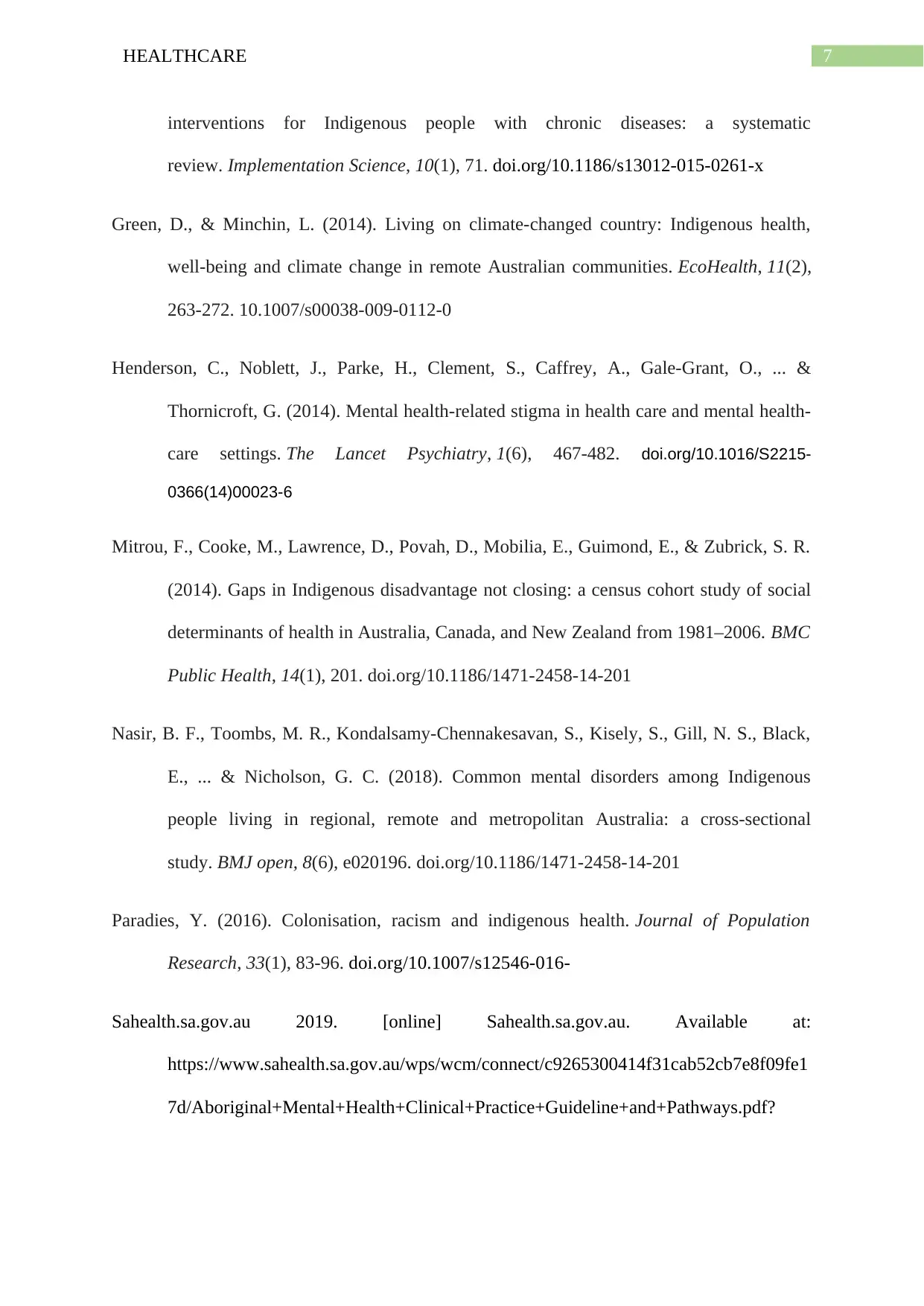
7HEALTHCARE
interventions for Indigenous people with chronic diseases: a systematic
review. Implementation Science, 10(1), 71. doi.org/10.1186/s13012-015-0261-x
Green, D., & Minchin, L. (2014). Living on climate-changed country: Indigenous health,
well-being and climate change in remote Australian communities. EcoHealth, 11(2),
263-272. 10.1007/s00038-009-0112-0
Henderson, C., Noblett, J., Parke, H., Clement, S., Caffrey, A., Gale-Grant, O., ... &
Thornicroft, G. (2014). Mental health-related stigma in health care and mental health-
care settings. The Lancet Psychiatry, 1(6), 467-482. doi.org/10.1016/S2215-
0366(14)00023-6
Mitrou, F., Cooke, M., Lawrence, D., Povah, D., Mobilia, E., Guimond, E., & Zubrick, S. R.
(2014). Gaps in Indigenous disadvantage not closing: a census cohort study of social
determinants of health in Australia, Canada, and New Zealand from 1981–2006. BMC
Public Health, 14(1), 201. doi.org/10.1186/1471-2458-14-201
Nasir, B. F., Toombs, M. R., Kondalsamy-Chennakesavan, S., Kisely, S., Gill, N. S., Black,
E., ... & Nicholson, G. C. (2018). Common mental disorders among Indigenous
people living in regional, remote and metropolitan Australia: a cross-sectional
study. BMJ open, 8(6), e020196. doi.org/10.1186/1471-2458-14-201
Paradies, Y. (2016). Colonisation, racism and indigenous health. Journal of Population
Research, 33(1), 83-96. doi.org/10.1007/s12546-016-
Sahealth.sa.gov.au 2019. [online] Sahealth.sa.gov.au. Available at:
https://www.sahealth.sa.gov.au/wps/wcm/connect/c9265300414f31cab52cb7e8f09fe1
7d/Aboriginal+Mental+Health+Clinical+Practice+Guideline+and+Pathways.pdf?
interventions for Indigenous people with chronic diseases: a systematic
review. Implementation Science, 10(1), 71. doi.org/10.1186/s13012-015-0261-x
Green, D., & Minchin, L. (2014). Living on climate-changed country: Indigenous health,
well-being and climate change in remote Australian communities. EcoHealth, 11(2),
263-272. 10.1007/s00038-009-0112-0
Henderson, C., Noblett, J., Parke, H., Clement, S., Caffrey, A., Gale-Grant, O., ... &
Thornicroft, G. (2014). Mental health-related stigma in health care and mental health-
care settings. The Lancet Psychiatry, 1(6), 467-482. doi.org/10.1016/S2215-
0366(14)00023-6
Mitrou, F., Cooke, M., Lawrence, D., Povah, D., Mobilia, E., Guimond, E., & Zubrick, S. R.
(2014). Gaps in Indigenous disadvantage not closing: a census cohort study of social
determinants of health in Australia, Canada, and New Zealand from 1981–2006. BMC
Public Health, 14(1), 201. doi.org/10.1186/1471-2458-14-201
Nasir, B. F., Toombs, M. R., Kondalsamy-Chennakesavan, S., Kisely, S., Gill, N. S., Black,
E., ... & Nicholson, G. C. (2018). Common mental disorders among Indigenous
people living in regional, remote and metropolitan Australia: a cross-sectional
study. BMJ open, 8(6), e020196. doi.org/10.1186/1471-2458-14-201
Paradies, Y. (2016). Colonisation, racism and indigenous health. Journal of Population
Research, 33(1), 83-96. doi.org/10.1007/s12546-016-
Sahealth.sa.gov.au 2019. [online] Sahealth.sa.gov.au. Available at:
https://www.sahealth.sa.gov.au/wps/wcm/connect/c9265300414f31cab52cb7e8f09fe1
7d/Aboriginal+Mental+Health+Clinical+Practice+Guideline+and+Pathways.pdf?
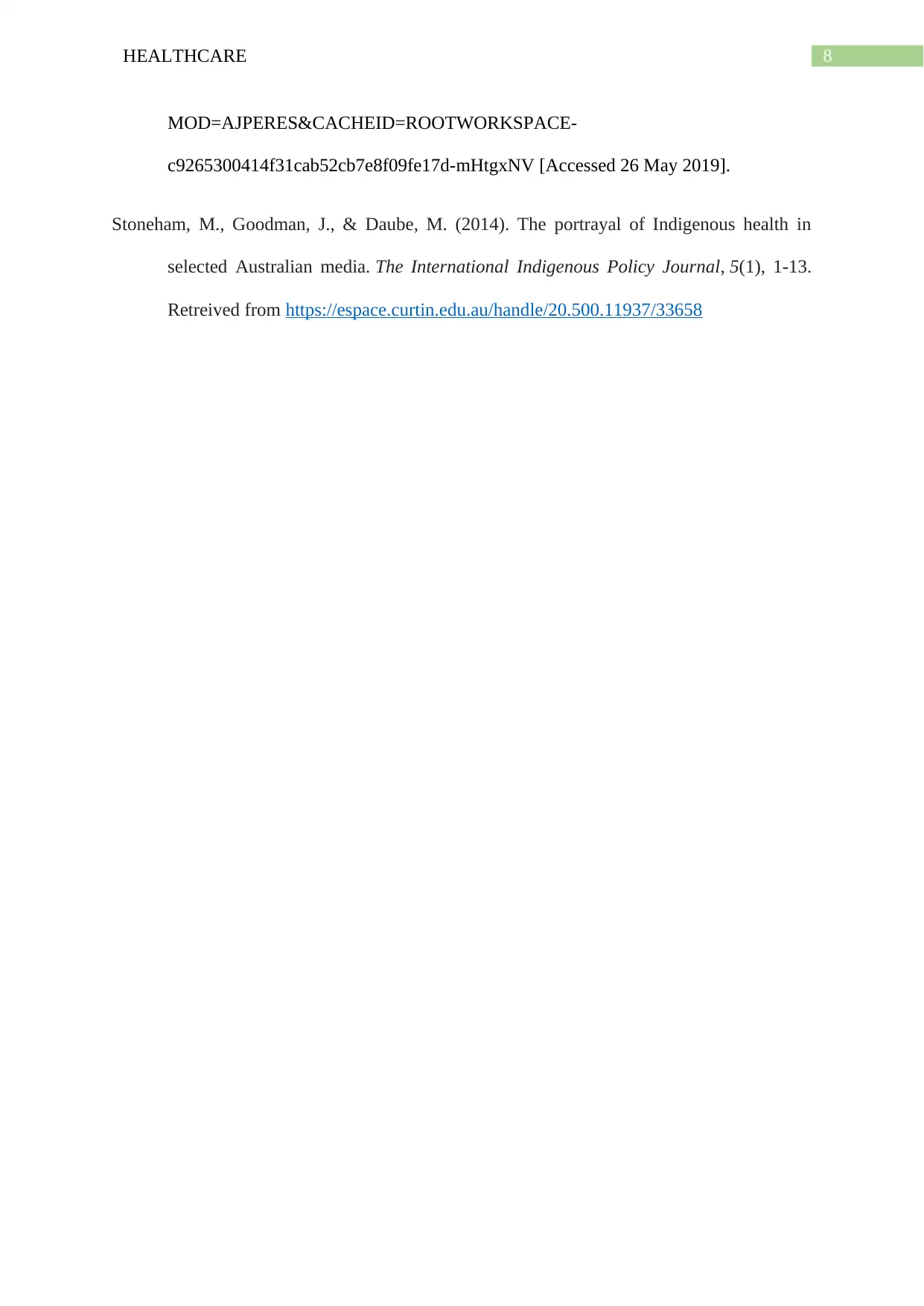
8HEALTHCARE
MOD=AJPERES&CACHEID=ROOTWORKSPACE-
c9265300414f31cab52cb7e8f09fe17d-mHtgxNV [Accessed 26 May 2019].
Stoneham, M., Goodman, J., & Daube, M. (2014). The portrayal of Indigenous health in
selected Australian media. The International Indigenous Policy Journal, 5(1), 1-13.
Retreived from https://espace.curtin.edu.au/handle/20.500.11937/33658
MOD=AJPERES&CACHEID=ROOTWORKSPACE-
c9265300414f31cab52cb7e8f09fe17d-mHtgxNV [Accessed 26 May 2019].
Stoneham, M., Goodman, J., & Daube, M. (2014). The portrayal of Indigenous health in
selected Australian media. The International Indigenous Policy Journal, 5(1), 1-13.
Retreived from https://espace.curtin.edu.au/handle/20.500.11937/33658
⊘ This is a preview!⊘
Do you want full access?
Subscribe today to unlock all pages.

Trusted by 1+ million students worldwide
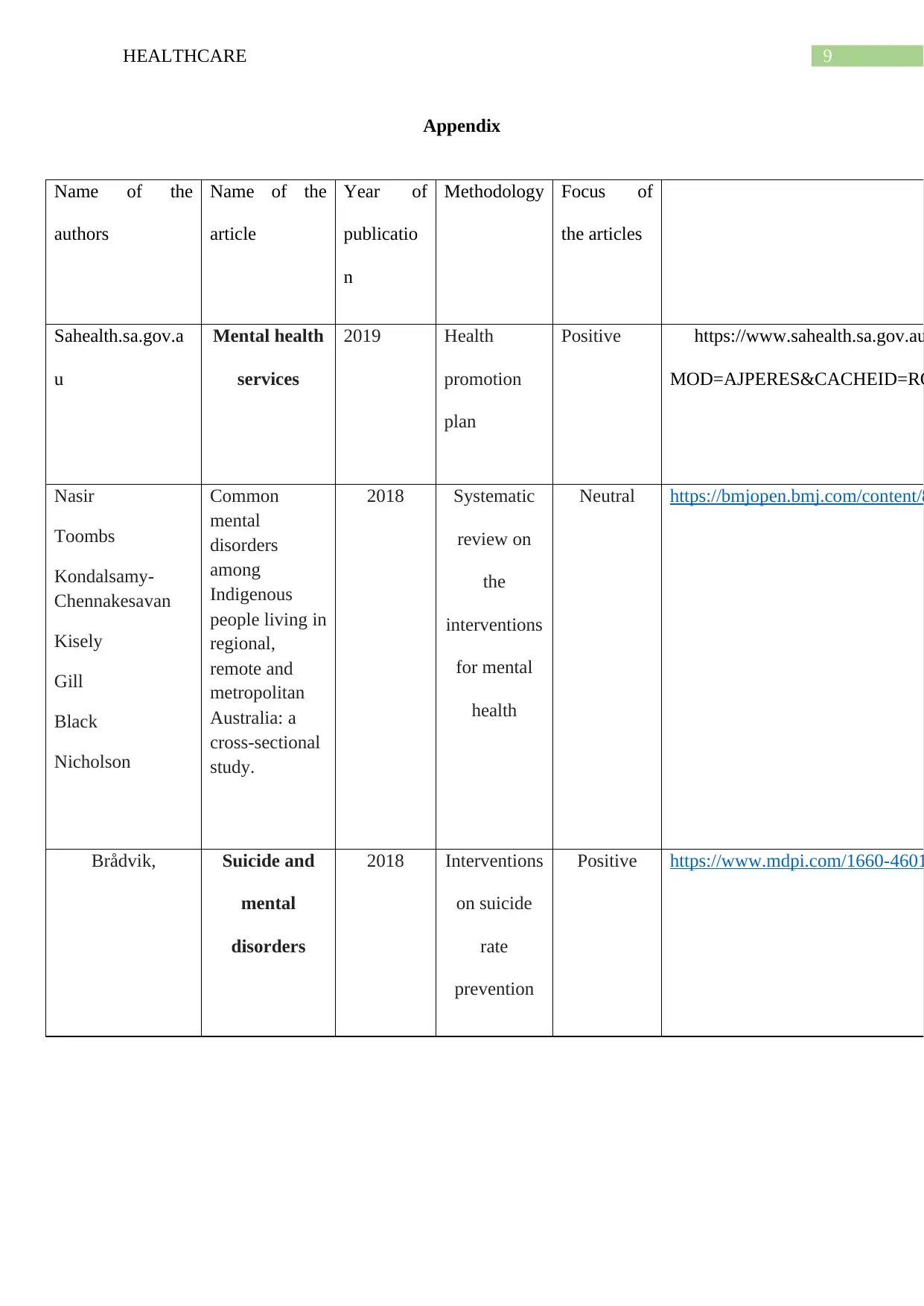
9HEALTHCARE
Appendix
Name of the
authors
Name of the
article
Year of
publicatio
n
Methodology Focus of
the articles
Sahealth.sa.gov.a
u
Mental health
services
2019 Health
promotion
plan
Positive https://www.sahealth.sa.gov.au
MOD=AJPERES&CACHEID=RO
Nasir
Toombs
Kondalsamy-
Chennakesavan
Kisely
Gill
Black
Nicholson
Common
mental
disorders
among
Indigenous
people living in
regional,
remote and
metropolitan
Australia: a
cross-sectional
study.
2018 Systematic
review on
the
interventions
for mental
health
Neutral https://bmjopen.bmj.com/content/8
Brådvik, Suicide and
mental
disorders
2018 Interventions
on suicide
rate
prevention
Positive https://www.mdpi.com/1660-4601
Appendix
Name of the
authors
Name of the
article
Year of
publicatio
n
Methodology Focus of
the articles
Sahealth.sa.gov.a
u
Mental health
services
2019 Health
promotion
plan
Positive https://www.sahealth.sa.gov.au
MOD=AJPERES&CACHEID=RO
Nasir
Toombs
Kondalsamy-
Chennakesavan
Kisely
Gill
Black
Nicholson
Common
mental
disorders
among
Indigenous
people living in
regional,
remote and
metropolitan
Australia: a
cross-sectional
study.
2018 Systematic
review on
the
interventions
for mental
health
Neutral https://bmjopen.bmj.com/content/8
Brådvik, Suicide and
mental
disorders
2018 Interventions
on suicide
rate
prevention
Positive https://www.mdpi.com/1660-4601
1 out of 10
Related Documents
Your All-in-One AI-Powered Toolkit for Academic Success.
+13062052269
info@desklib.com
Available 24*7 on WhatsApp / Email
![[object Object]](/_next/static/media/star-bottom.7253800d.svg)
Unlock your academic potential
Copyright © 2020–2025 A2Z Services. All Rights Reserved. Developed and managed by ZUCOL.




